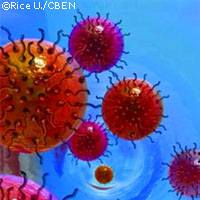Nanotechnology and the environment: beauty rather than beast?
Much has been said about the potential of nanotechnologies to revolutionise the way we live, with the biggest changes forecasted to take place in materials, surveillance and healthcare. The accompanying discussions on the possible side effects of working at the nanoscale may suggest to the casual observer that the environment will be a loser in the nano-revolution. Not so, according to scientists investigating environmental nanotechnology. Warnings have been sounded about the unknown effects of nanoparticles on human health and the environment, and many have called for studies into ecotoxicology to accompany nano research. Possible dangers are related to: the potential for dispersion and exposure; increased likelihood of chemical reactivity; particles could act as a carrier for contaminants, providing rapid and long-range transport; and the difficulty of recovering material at the end of its life. But scientists working in the comparatively unknown field of environmental nanotechnology argue that working at the nanoscale does not have to be to the detriment of the environment. Studies have shown that nanotechnologies can be used to not only monitor and prevent pollution, but to clean up pollutants once they have already made their way into the environment. Given policy makers' increased focus on how emissions can be cut, and the environment protected, the lack of discussion on how nanotechnologies could help is a surprising oversight. Recognising the potential of environmental technologies, the European Commission published an action plan on this specific field in 2004, which recognises that nanotechnologies have an important role to play. The Commission also funded several projects in the area under the Sixth Framework Programme (FP6). According to David Rickerby from the Institute for Environment and Sustainability of the European Commission's Joint Research Centre (JRC), countries such as the US and Japan are ahead of Europe in environmental nanotechnologies. 'In Japan they have recognised that solutions to various problems could be found in nanotechnology. They have also realised that there is a huge market for this field, which is also driving more research,' Dr Rickerby told CORDIS News. 'The field is a little under-funded in Europe. In Europe we've tended to focus on health applications and the risks of nanoparticles in comparison with North America. This is not an unwise decision, but means that the nano-advantages for the environment are under-funded in comparison to the US,' he said. Dr Rickerby added that other 'nano-advantages', affecting for example medical applications and manufacturing, have received targeted EU funding through European Technology Platforms. There have however been some breakthroughs in Europe. A UK company is incorporating nanoparticles into paints. The paints are self-cleaning and able to remove pollutant particles from the atmosphere. Ecopaint is designed to reduce levels of nitrogen oxides, which cause respiratory problems and smog. The New Scientist explained in 2004 how the paint works: 'The paint's base is polysiloxane, a silicon-based polymer. Embedded in it are spherical nanoparticles of titanium dioxide and calcium carbonate 30 nanometres wide. [...] The polysiloxane base is porous enough to allow NOx to diffuse through it and adhere to the titanium dioxide particles. The particles absorb ultraviolet radiation in sunlight and use this energy to convert NOx to nitric acid.' The acid is then either washed away by rain, or neutralised by the alkaline calcium carbonate particles. The development of testing procedures for checking that new and innovative products really do what they claim to do would be a good place to start increasing international collaboration in environmental nanotechnologies, believes Dr Rickerby. In the meantime, pan-European collaboration is ongoing in three FP6 projects: PICADA, NANOS4 and AMBIO. PICADA (Photocatalytic Innovative Coverings Applications for De-pollution Assessment), in which the JRC is a partner, is seeking a solution to the phenomenon of facade soiling and staining, which has been exacerbated by atmospheric pollution in recent decades. The soiling has impacts for the quality of the urban environment, and the life cycle cost of the buildings. The team is using photocatalysis by titanium dioxide to develop innovative materials with both de-soiling and de-polluting properties that can be applied to facades. Coatings are also the focus of the AMBIO (Advanced Nanostructured Surfaces for the Control of Biofouling) project. The 31-partner Integrated Project has as its objective the development of antifouling coatings that function through their nanoscale physico-chemical properties, without the release of biocides, which may damage the environment. Fouling has been controlled traditionally with antifouling paints that contain compounds which are toxic to the organisms. But regulations now require that antifouling paints must not cause adverse effects in the environment, and the search is therefore underway for more environmentally friendly ways of deterring marine life from attaching itself to the hull of a vessel. Protecting the environment with the use of a gas sensing system is the main objective of NANOS4 (Nano-structured solid-state gas sensors with superior performance). The team is using advanced micro- and nanotechnologies to develop innovative metal-oxide gas sensing systems. Sensors will be constructed using nanoengineering techniques such as 'vapour phase transport process crystal growth'. The role that nanotechnology can play in solving environmental problems will be investigated further at a session entitled 'Nanotechnology: Environmental technology for the future?' taking place as part of the EU's Green Week from 12 to 15 June.



